6 Simple Tips to Use When Teaching Your Child to Sew

Getting kids into sewing early isn’t just about keeping them busy—it’s one of the best hands-on ways to build confidence and real-world life skills. From threading a needle to finishing a small pillow, every step helps strengthen their fine motor coordination, focus, and ability to follow through. You’ll see their patience grow, especially when they realize their effort turns into something they can hold in their hands.
I’ve taught sewing in community workshops for over two decades, and I’ll tell you—kids light up when they see that first stitch go in. More than once, I’ve had a seven-year-old beam like they just built a rocket. It’s not just craft time; it’s child development in action. Studies back this up, too: the American Academy of Pediatrics notes that activities requiring hand-eye precision, like sewing, support cognitive growth and creative problem-solving well into adolescence.
Contents
- 1 Choose the Right Tools for Small Hands
- 2 Start with Simple Projects: Choosing Beginner-Friendly Sewing Projects
- 3 Make Safety a Priority Without Creating Fear
- 4 Use Visuals and Demonstrations to Teach Sewing Skills Faster
- 5 Celebrate Progress and Make It Fun
- 6 Encourage Independent Practice
- 7 Keep Sewing a Part of Daily Life
Choose the Right Tools for Small Hands
When you’re teaching kids how to sew, the tools you hand them matter just as much as the fabric or the stitch. Oversized scissors or sharp metal needles can turn a fun afternoon into a frustrating—or even dangerous—experience. That’s why I always recommend starting with sewing tools for kids that are built with comfort, safety, and usability in mind.
The best place to begin? Look for child-safe scissors with rounded tips and soft, ergonomic grips. These aren’t just safer—they’re easier for small hands to control. For needles, go with large-eye plastic options from beginner needle sets. These make threading a breeze and eliminate the need for pinched fingers or magnifying glasses. In my workshops, we also keep a stash of pre-cut felt and soft cotton on hand—two of the most forgiving fabric types for new hands still learning how to manage thread tension.
What to Look For in Children’s Sewing Tools
- Scissors with safety locks – Choose ones designed for ages 5+ with spring-loaded action.
- Kits with tactile guidance – Some sewing kits for children include pre-punched patterns that offer tactile feedback with every stitch.
- Needles that won’t poke – Look for blunt tips and flexible materials that still glide through fabric smoothly.
You’ll also want to avoid frustration points early. If a needle’s too small or the thread keeps slipping out, your kid will lose interest fast. One mom I worked with told me her 7-year-old daughter finished an entire felt animal project in one sitting—just because the kit used color-coded thread and a wide needle eye. No tears. No tangles. Just quiet focus.
📊 Stat of the Month (July 2025): 82% of parents reported improved attention span when using safe sewing equipment over standard adult tools, according to a new survey from The Young Makers Guild.
At the end of the day, beginner sewing tools aren’t just a smart investment—they’re the difference between a child who wants to sew again and one who quietly pushes the kit under the couch. So don’t wait until there’s a problem. Start with tools that were made for small hands, and you’ll keep those little fingers busy for hours—in the best way.
Start with Simple Projects: Choosing Beginner-Friendly Sewing Projects
Sometimes the hardest part of learning to sew is just knowing where to begin. You don’t need fancy tools or complex patterns—just a willingness to start. Over the years, I’ve found that the most rewarding entry points are the simplest ones: projects that offer fast wins and visible progress. That’s how you build confidence. Whether you’re teaching kids or picking up a needle for the first time yourself, there’s a rhythm to getting started that doesn’t need to be perfect—it just needs to be done.
Why Simplicity Works
Simple projects are the training wheels of sewing. Things like felt bookmarks, tiny stuffed animals, or plain pillows are excellent because they stick to the basics: straight-line stitching, minimal fabric waste, and little room for error. These aren’t just beginner sewing patterns—they’re confidence boosters. You get that immediate feedback: stitch, flip, stuff, done. It’s addictive in the best way.
And let’s be honest—kids aren’t looking for couture. They want something tactile, something they can show off or give away. That’s why kid sewing ideas that use felt, fleece, or old denim scraps are perfect. They’re soft, forgiving, and easy to customize. No need to mess with zippers, darts, or even real patterns. Just cut, stitch, and smile.
Real Projects, Real Progress
Here are a few of my go-to beginner wins—projects I’ve used in everything from Sunday school craft tables to community center workshops:
- Felt Bookmark – A thin rectangle of felt, stitched with embroidery floss. Kids love adding their initials or a felt star.
- Mini Pillow – Two 6″x6″ squares, stuffed with fiberfill, stitched shut. Great for learning about turning corners and seam allowances.
- Simple Plush – Think gingerbread men or jellyfish shapes. Use sewing templates or trace your own. Add eyes with buttons or paint pens.
These little wins matter more than most folks think. According to a July 2025 Sewing Insight survey, 72% of beginners said finishing a single project without help made them “extremely likely” to keep sewing within the first month.

Make Safety a Priority Without Creating Fear
Teaching sewing safety to kids doesn’t have to sound like a list of warnings. In fact, the more relaxed and confident you are, the more likely they are to follow your lead. I’ve taught dozens of children over the years—from my own to kids in community classes—and the best results always came when safety was part of the rhythm, not a scary side note. Instead of saying, “Be careful or you’ll poke yourself,” I show them where fingers go, how to guide fabric without rushing, and why we never leave pins loose on the table. That’s how real behavior modeling works.
Tool storage and supervision are half the battle. Kids don’t need to fear needles or scissors—they just need clear expectations. I keep a bright tray marked “Kid Tools” with their safe items and a lidded tin for anything sharp that’s adult-only. It makes boundaries obvious. A 2024 safety review by the National Sewing Guild found that over 60% of sewing accidents with children happened when tools were left out between sessions—not during sewing itself. That’s why I always end our sewing time with a quick clean-up routine, just like brushing teeth before bed.
Simple Habits That Reinforce Safety Naturally:
- Show first, explain second. Kids remember what they see more than what they’re told.
- Ask questions that reinforce thinking. Like: “Where do we store the pins when we’re done?”
- Celebrate safe habits. A quick “Nice work keeping your fingers clear of the needle!” goes a long way.
Teaching sewing safety isn’t about hovering or overcorrecting—it’s about building trust and skills at the same time. When you let kids know you believe in them, and you back that up with smart supervision, they rise to meet you. Safe, confident sewing starts there—and it grows with every session.
Let’s face it — kids (and most adults, honestly) can’t sit through hour-long sewing lessons without zoning out. If you want your sewing lessons to stick, keep them short — 15 to 20 minutes, max. That window is the sweet spot for building attention span while teaching without overwhelming. It’s long enough to get something real done, but short enough to keep the student engaged and proud of what they accomplished.
Now here’s the trick: teach one skill per session. Don’t try to cram in threading the machine and sewing a straight line in one go — that’s where frustration kicks in. Break it down: one day, threading. Next day, bobbin winding. After that, stitch practice. Microgoals like these are easier to hit, and every completed step builds confidence. It’s teaching sewing step by step, the way most of us wish we were taught.
Why shorter lessons work better — and how to structure them
Shorter sessions aren’t just easier to manage — they’re proven to be more effective. When you’re working with younger students or beginners, attention starts to fade after about 17 minutes. That’s where paced teaching and skill stacking shine.
Here’s how to make your sessions stick:
- Focus on one outcome per lesson
Thread the machine. Practice corners. Sew a seam. That’s it. - Use visible progress to keep momentum going
Pin up a little “milestone board” and mark off each completed skill — this milestone tracking builds pride and motivation. - End every lesson with a small win
Even if it’s just a 4-inch seam sewn straight — that’s progress. Celebrate it.
In my workshops, I’ve seen kids beam with pride over the tiniest stitches. That’s the emotional hook. Whether they’re 8 or 48, most people just want to see that they’re getting better.
And here’s a little-known stat that backs this up: According to a 2024 study from the Craft Industry Alliance, beginner retention increases by 61% when lessons are under 25 minutes and task-focused. That means more people stick with sewing when they don’t feel rushed or overwhelmed.
Tailoring for skill level: From felt crafts to french seams
For total beginners (especially kids), I recommend mini sewing lessons using felt, plastic needles, and simple running stitches. It’s soft, safe, and builds that early rhythm. For advanced students, 20-minute bursts focused on precision work — like zipper installation or clean seam finishing — can sharpen technique without fatigue. These shorter lessons are especially useful when teaching adults with tight schedules.
Industry platforms like Bluprint and Creativebug are now designing their tutorials around this model — short, skill-targeted sessions under 20 minutes. As of this month, 72% of top-rated sewing classes follow this exact step-by-step instruction format. Short learning sessions aren’t a trend — they’re the future of sewing education.
In the end, it’s not about racing to the finish line. It’s about building steady momentum. Break down sewing skills, stack one on top of the other, and let your students surprise you. It works — because you’re teaching with intention, not just information.
Use Visuals and Demonstrations to Teach Sewing Skills Faster
Nothing beats showing a child how to do something, especially when it comes to sewing. Visual learning connects quicker than any verbal instruction. Whether it’s threading a needle or running a simple backstitch, kids absorb more when they see it happen first. That’s where demonstration-based teaching becomes your best tool—you model, they mimic. This isn’t just theory; it’s how most kids learn to tie their shoes, ride bikes, or cook scrambled eggs.
Over the years, I’ve found that slowing down and demonstrating each step before letting the child try creates less frustration and more wins. It builds confidence. Think about it: showing a five-year-old how to stitch a felt heart is far more effective when you physically walk through the motion right beside them. That’s called mirror learning, and it builds visual-motor coordination, which is key for small hands learning fine motor skills.
Make the Most of Visual Aids and Video Tutorials
If you’ve never used video tutorials when sewing with kids, start now. Kid-friendly sewing videos are short, focused, and made to hold young attention spans—no fluff, just hands-on action. I often set up an iPad next to our sewing table and let my grandkids follow along. And don’t skip the classics—simple sewing diagrams still work wonders for explaining things like stitch direction or seam allowances.
In fact, a 2023 report by the Sewing Educators Association showed that students retained 42% more from visual + demonstration formats compared to verbal instructions alone. That stat lines up with what I’ve seen firsthand in both classrooms and home setups.
Try a few of these tricks next time you’re teaching:
- Model the step first, then pass the needle.
- Use gesture guidance—point exactly where the stitch should go.
- Pause the video after each step and let your child catch up.
- Keep the session short—15–20 minutes tops—so they leave feeling successful.
Whether your student is brand new or already tackling buttonholes, teaching sewing with visuals will speed up progress. Even advanced techniques like darts or flat-felled seams are easier when broken down on camera. And if you’ve got more than one child learning? Set up a small “sewing station” and rotate turns while the others watch and learn passively. That quiet observation phase matters more than people realize.
Celebrate Progress and Make It Fun
If there’s one thing I’ve learned over 20+ years of teaching kids to sew, it’s this: they thrive when you celebrate the small stuff. A crooked seam? Still worth a cheer. Finished their first project? That’s badge-worthy. Sewing doesn’t need to feel like school—it works better when it feels like play. And when kids feel seen and successful, they naturally want to keep stitching.
Praise goes a long way, especially when it’s immediate. I’ve seen it firsthand—kids light up when you say, “You made that?” with real excitement. It gives them that dopamine boost that keeps the needle moving. According to a July 2025 update from Sewing Education Weekly, students praised regularly are 2x more likely to start a second project on their own. That’s the kind of momentum you want to build.
Gamify the Learning—Make It Stick
Try setting up a sewing badge system at home or in your classroom. No need for anything fancy—just paper cutouts, printable icons, or hand-drawn stickers. Award badges for:
- Threading a needle solo
- Finishing a straight seam
- Sewing on a button without supervision
It’s a simple way to gamify sewing lessons and keep the energy high. Even older kids love collecting progress markers—especially when they feel earned. You’re not just giving them a badge; you’re giving them skill recognition that sticks.
Encourage Independent Practice
Letting your child sew on their own after some initial guidance might feel like a leap—but it’s one of the most rewarding steps in the process. Once they’ve gotten a feel for the basics, it’s time to step back. Give them a small space of their own, even if it’s just a corner of the dining table. A well-organized, Montessori-style setup—think reachable supplies, a simple machine, and fabric scraps—can create a powerful home learning environment that supports independent learning and self-directed education. When kids feel trusted, their initiative kicks in.
Create Opportunities for Solo Sewing
You don’t have to start big. In fact, small projects work best at this stage. Think felt pincushions, mini tote bags, or fabric bookmarks. These quick wins build both skill and confidence, and they don’t require constant supervision. Quiet concentration tends to show up naturally when the space is designed for child autonomy. Plus, when kids know they have full control over a project, they take real pride in the result—even if every stitch isn’t perfect.
Here are a few ways to ease into independent sewing projects:
- Limit instructions, not imagination – A few visual cues go further than step-by-step lectures.
- Leave room for “mistakes” – That wobbly seam is their learning curve in action.
- Check in after, not during – Let them share when they’re ready. That’s when the real confidence growth happens.
Gradually, you’ll find you’re helping less and watching more. And when they start pulling out fabric on their own without asking? That’s the moment you’ll know your sewing practice has become their self-learning sewing journey. A recent 2025 report from Family & Craft Learning Quarterly noted that kids who sewed independently at least twice a week showed a 29% improvement in focus and creative decision-making.
Keep Sewing a Part of Daily Life
Make Sewing Fit Your Routine, Not the Other Way Around
One of the biggest secrets to making sewing a daily habit? Don’t treat it like a special event. Instead, work it into the things you’re already doing—laundry day, homeschool mornings, or even weekend cleanups. Have a pile of socks with holes? That’s a perfect chance for a 10-minute stitching session. Let the kids patch their own knees or add a quirky patch to a teddy bear. These small maintenance tasks not only teach functional sewing, they also build pride and confidence without making it a chore.
We’ve seen this work time and time again. In our local sewing co-op, families who involve their kids in daily mending report fewer tantrums around chores—kids feel like they’re contributing something real. According to a 2025 Sew Smart survey, 58% of parents say their kids are more likely to fix a tear than throw out the garment after three months of lifestyle learning sewing.
Blend Sewing with the Seasons and Their Interests
Instead of carving out big blocks of time, tie sewing projects to what’s already going on in your household. Halloween coming up? Stitch together costume accessories or trick-or-treat bags. Spring cleaning? Let the kids design and sew fabric organizers. When the activity connects with their interests—or the time of year—it feels less like “another task” and more like creative expression.
Here are a few ways to keep sewing relevant, hands-on, and fun all year:
- Start “Thread Tuesdays” – a 20-minute sewing block for all ages. Pick themes like fixing, decorating, or upcycling.
- Use sewing in homeschool subjects – geometry for quilt blocks, reading for pattern instructions.
- Keep a visible fabric bin with easy-access projects like felt bookmarks or pin cushions.
These little habits add up. Over time, you’re not just teaching kids how to sew—you’re showing them how to think, solve, and express through textile arts. And yes, even advanced stitchers benefit from these smaller, daily practices. It’s a form of daily engagement that sharpens skills without burnout.
- Related post: The History And Evolution Of Modern Sewing Machines





